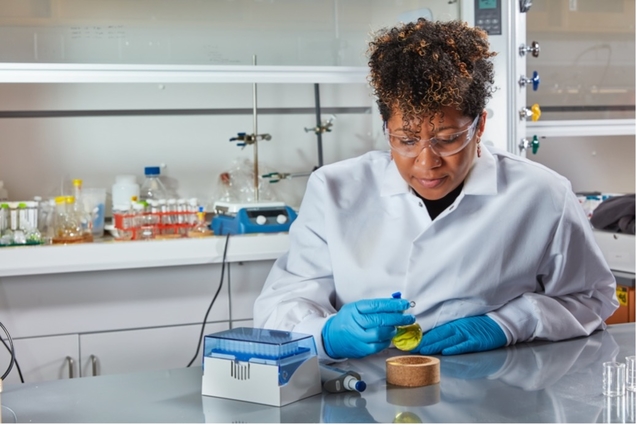Breaking down barriers: Sharee Harris shares her career story
 (Download Image)
(Download Image)
Sharee Harris, an analytical chemist for the Physical and Life Sciences organization, hopes to connect students at historically black colleges and universities, like her alma mater South Carolina State University, to career paths in the sciences at national laboratories. For one of her research projects, she uses CeO2 — known as Cerium(IV) oxide — to synthesize nanoparticle feedstocks for applications in post-detonation nuclear forensics exercises.
A common misconception is that those interested in technical roles at a national laboratory must hold a graduate degree such as a Ph.D. On the contrary, roughly 40% of the science, technology and engineering workforce at Lawrence Livermore National Laboratory (LLNL) claim an associate’s or bachelor’s degree as their highest education level.
This false narrative is something that Sharee Harris, an analytical chemist for the Physical and Life Sciences (PLS) Directorate, hopes to change through her recruiting and mentoring efforts with students at historically black colleges and universities (HBCUs).
“A majority of HBCU students don’t realize the opportunities that are out there or know that you don’t need a Ph.D. to be a scientist at a governmental facility,” Harris said. “Additionally, most of these students don’t usually have the opportunity to go to graduate school, with many of them having to jump right into the workforce.”
After earning her bachelor’s degree in chemistry with a concentration in radiochemistry from HBCU South Carolina State University (SC State), Harris spent several years gaining relevant experience as a pharmacy technician and later as an analytical chemist before joining LLNL in 2019. At the time, Harris recalls being unsure if she would even qualify for the position.
“If there is one thing I have learned,” she said, “it is to not put yourself in a box. It is better to at least try and take a chance, and let someone else tell you that you are not qualified, rather than miss out on a potential opportunity.”
The large, multidisciplinary research projects that LLNL is known for require diverse technical roles, Harris said: “Those with a bachelor’s degree, like myself, have a different skill set. While we may not work on a specific project from start to finish, we are typically on the ground floor getting the work done and taking direction as needed. After all, you can’t have too many chefs in the kitchen — you always need some cooks.”
To give back and help current HBCU students realize their path and place in the sciences, Harris remains involved in LLNL-HBCU recruiting efforts alongside LLNL scientists Jason Jeffries and Bradley Childs. Earlier this year, Harris and Childs held an interactive open forum at their alma mater SC State for students to ask them questions about their educational and career paths.
In her spare time outside of LLNL, Harris also mentors four to five HBCU students a year. She said: “My goal is to create pipelines for HBCU students, ultimately bringing the diverse talent that these schools have to offer to Lawrence Livermore.”
At LLNL, Harris is a certified fissile material handler for the Laboratory’s Plutonium Processing Facility. In this role, she uses different tools and techniques to support elemental or isotopic breakdowns. Such analyses can be used as a verification step to ensure processes are working properly or to monitor criticality controls.
Whereas some analytical chemists are experts using one instrument, Harris is interested in working with and learning about various instrumentation types. Her favorite so far is the inductively coupled plasma mass spectrometer (ICPMS), a highly sensitive instrument that can measure trace levels of elements in a sample.
Beyond her ongoing role in the Plutonium Processing Facility, Harris contributes to other PLS research efforts, such as the Hydride-Dehydride Project, which aims to develop custom alloy powders and produce spherical metal powders for reducing potential cracks and mechanical failures in lightweight structural materials, bioimplants and energy storage materials. For a separate project, she developed silica particles to be used as a surrogate debris reference — a test sample — for nuclear forensic response efforts, applicable in the event of a nuclear incident.
Harris attributes a lot of her success in the nuclear sciences and at LLNL to her radiochemistry coursework at SC State — an area of study that is not offered at many schools. Surprisingly, while Harris was pursuing her degree, she told herself that she wanted to do anything but analytical chemistry. As it turns out, she loves this particular field.
—Shelby Conn
Contact
 Anne M. Stark
Anne M. Stark
[email protected]
(925) 422-9799
Tags
Advanced Materials and ManufacturingCareers
Physical and Life Sciences
Materials Science
People
Featured Articles







